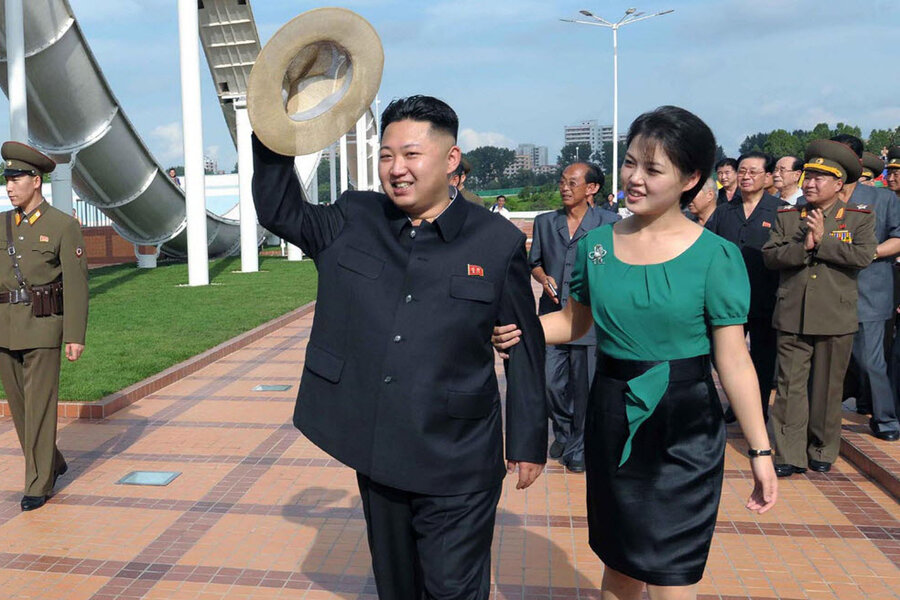Family man and friendly leader? Kim Jong Un gets positive spin at home
| Seoul, South Korea
The outside world focuses on the messages of doom and gloom from North Korea: bombastic threats of nuclear war, fantasy videos of US cities in flames, digitally altered photos of leader Kim Jong Un guiding military drills. But back home, North Koreans get a decidedly softer dose of propaganda: Kim portrayed as a young, energetic leader, a people person and family man.
Mixed in with the images showing Kim aboard a speeding boat on a tour of front-line islands, or handing out commemorative rifles to smartly saluting soldiers, are those of Kim and his wife clapping at a dolphin show or linking arms with weeping North Korean children.
The pictures can look odd or obviously staged to outsiders. But they're carefully crafted propaganda meant to give North Koreans an image of a country governed by a leader who is as comfortable overseeing a powerful military as he is mingling with the people.
Analysts say the images also hint at something that often gets lost amid the threatening rhetoric: North Korea's supreme commander isn't an all-powerful, isolated monarch who can govern without considering his people's approval. Kim is still busy building his reputation at home.
"Even dictatorships respond to public opinion and public pressure," said John Delury, a North Korea analyst at Seoul's Yonsei University. "He's expected to pay attention to and make improvements in the common people's standard of living. They've put that promise out in their domestic propaganda."
It's a tall order. Living standards in Pyongyang, the capital, are relatively high, with new shops and restaurants catering to a growing middle class. But U.N. officials' reports detail harsh conditions elsewhere in North Korea: up to 200,000 people estimated to be languishing in political prison camps, and two-thirds of the country's 24 million people facing regular food shortages.
When it comes to North Korean propaganda, much of the world focuses on the series of outlandish videos uploaded to the country's YouTube channel and government website, largely for foreign consumption. In one fantasy, missiles rain down on a burning American city while an instrumental version of "We Are the World" plays in the background. In another, President Barack Obama and US troops burn.
But what most North Koreans see on state TV is a different propaganda message: Kim Jong Un bending down to receive flowers from children, Kim visiting families living in rustic homes on front-line islands, Kim mobbed by gushing female soldiers.
As with any propaganda or PR, the images are carefully staged. And many make foreign news headlines only when experts and photo editors discover that North Korea is digitally altering them. For instance, in a picture distributed recently by state media, troops and hovercraft land on a barren, snow-dappled beach. Experts say some of the multiple hovercraft have been copied and pasted into the image.
But North Korea's propaganda makers aren't concerned about the criticism abroad to their heavy-handed photo editing. "These efforts are aimed more at an unsophisticated domestic peasant audience than those of us who are more discerning," said Ralph Cossa, president of the Pacific Forum CSIS think tank in Hawaii.
The caring domestic persona being built for Kim by his image specialists is aided by his wife, Ri Sol Ju.
She is young and glamorous, a chic and smiling presence at his side in many of the country's propaganda images. The couple is often photographed at amusement parks, nurseries, factory tours and concerts.
"It's a more complex kind of image he has as a leader," Delury said. "The basis of his legitimacy domestically has to do with these other, non-military things."
The propaganda machine in North Korea also worked to build up a caring image for Kim's father, the late Kim Jong Il. He doggedly appeared at tours of factories, farms and military posts. But while Kim Jong Un puts his wife front and center and is a relaxed presence on camera, his father was stiff in photos and secretive about his family life.
North Korea takes pains to select and sometimes alter photos so its leaders appear in the best light possible, said Seo Jeong-nam, a North Korean propaganda expert at Keimyung University in South Korea.
For example, past propaganda specialists were careful not to pick photos that showed the large lump on the back of the neck of Kim's grandfather, North Korean President Kim Il Sung, Seo said. When Kim Jong Il was alive, North Korean photographers tried to make him look taller in photos than he actually was, often positioning him slightly in front of others, Seo said.
As for Kim Jong Un, Seo said North Korea's propaganda mill chooses photos that show off his strong resemblance to his grandfather, who still is depicted on state TV as the loving father of the nation, surrounded by children and adoring citizens.
Associated Press writer Sam Kim contributed to this story. Follow Klug at www.twitter.com/APKlug and Kim at www.twitter.com/samkim_ap.






